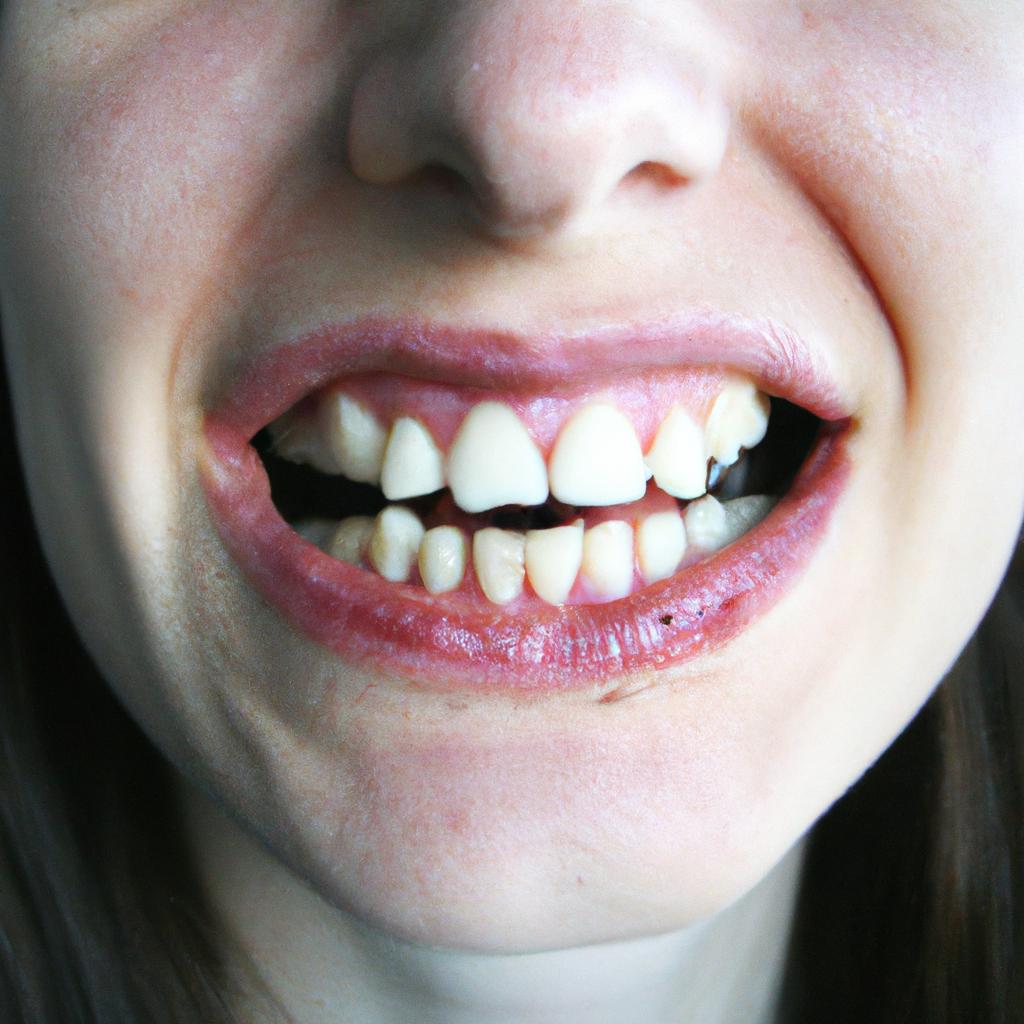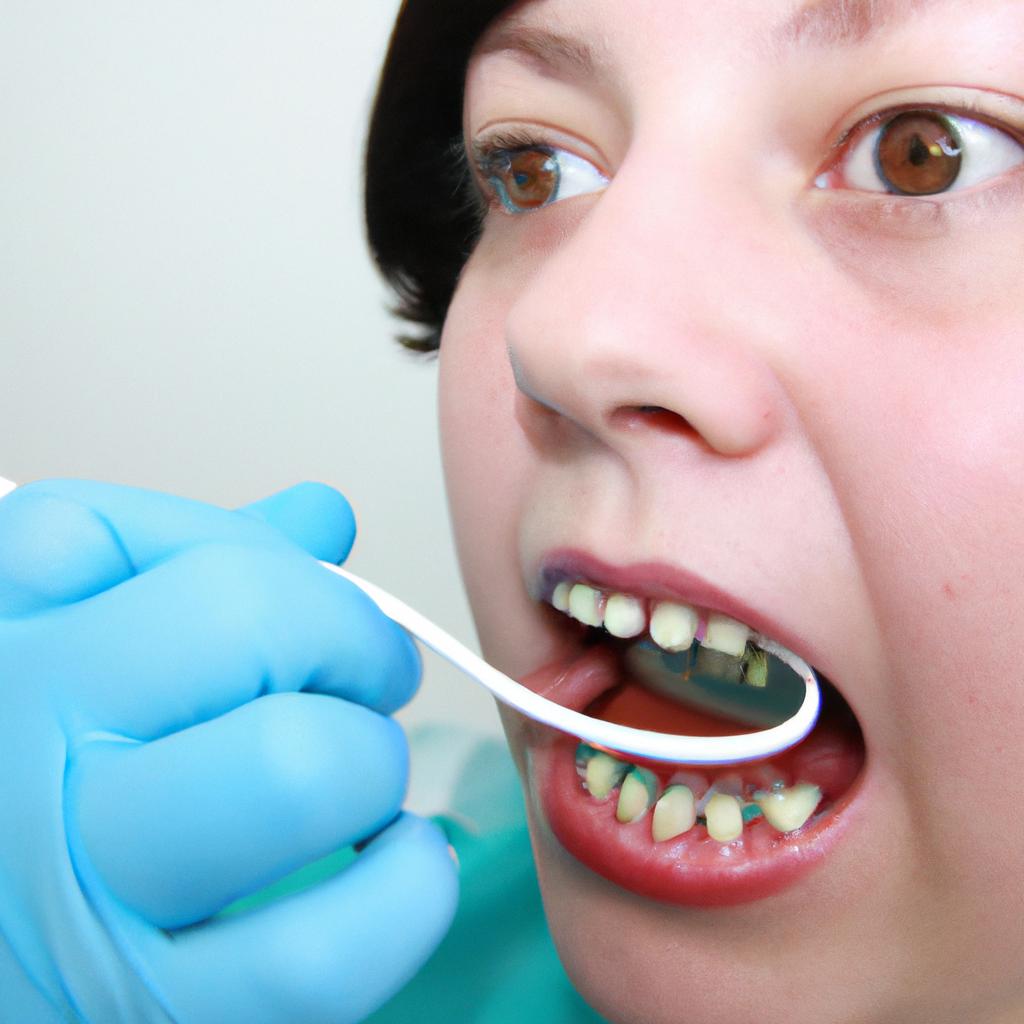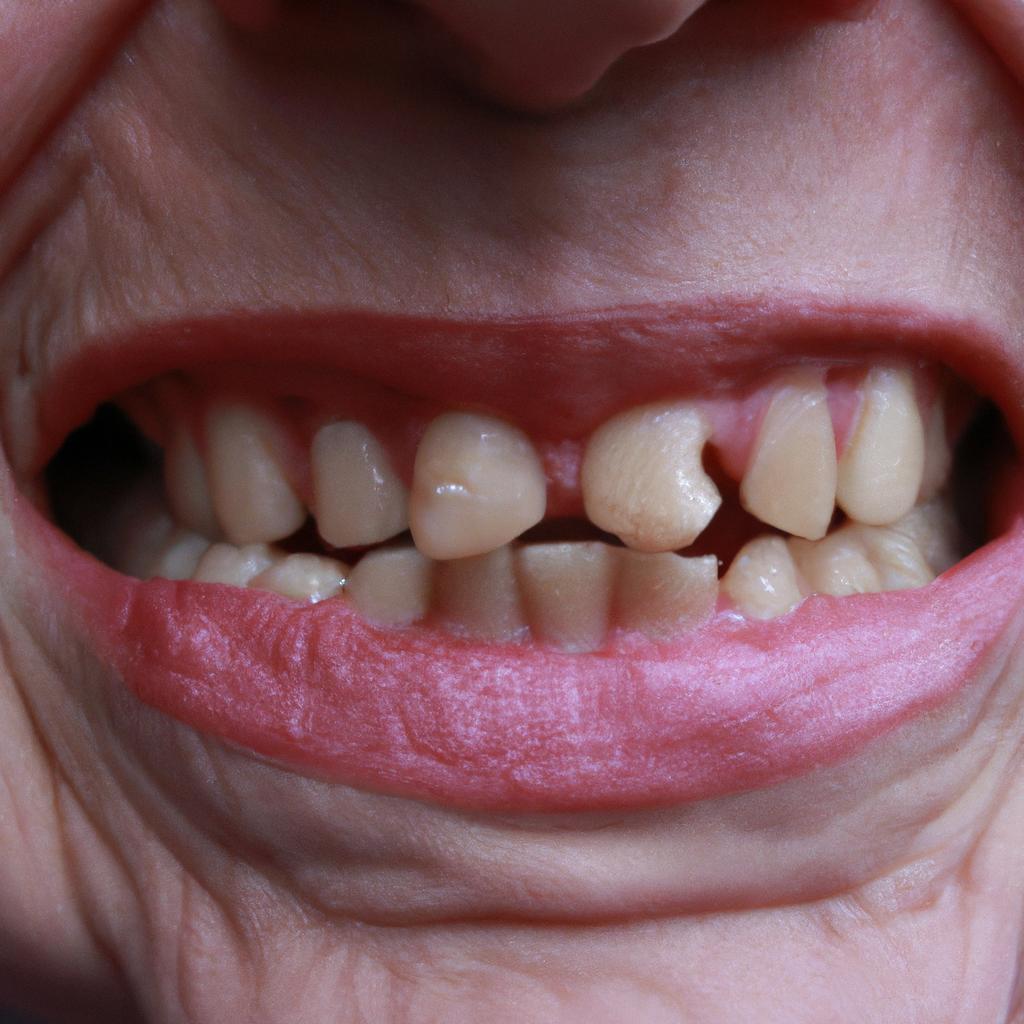Implant-Supported Prosthesis in Prosthodontics: Enhancing Dental Specialty

Implant-supported prosthesis has revolutionized the field of prosthodontics by providing a stable and long-lasting solution for patients with missing teeth. This innovative treatment involves the use of dental implants, which are titanium fixtures placed in the jawbone to support artificial teeth or dentures. The success rate of implant-supported prostheses is remarkably high, making it an attractive option for individuals seeking functional and aesthetic improvement. For instance, consider the case of Mr. Johnson, a 55-year-old patient who had lost multiple teeth due to advanced periodontal disease. With the placement of dental implants and subsequent attachment of a fixed bridge, he was able to regain his ability to chew comfortably and confidently.
The utilization of implant-supported prosthesis in prosthodontics not only enhances oral function but also improves overall quality of life for patients. Unlike traditional removable dentures that can cause discomfort and instability, implant-supported prostheses provide exceptional stability and retention. This allows individuals to enjoy their favorite foods without restriction and speak with confidence. Moreover, these prostheses closely mimic natural teeth in terms of appearance and feel, restoring patients’ self-esteem and social interactions. Consequently, this advancement in prosthodontic treatment has become increasingly popular among both patients and dentists alike.
Implant-supported prostheses offer numerous advantages over traditional treatment options. Firstly, they provide a more permanent solution for missing teeth, as dental implants integrate with the jawbone and become a part of the patient’s oral anatomy. This stability and longevity result in improved durability compared to removable dentures, reducing the need for frequent repairs or replacements.
Secondly, implant-supported prostheses help preserve bone density in the jaw. When natural teeth are lost, the underlying jawbone can deteriorate over time due to lack of stimulation. Dental implants mimic the function of tooth roots, stimulating the surrounding bone and preventing further bone loss. This not only maintains facial structure but also prevents issues such as sunken cheeks or collapsed lips that can occur with traditional dentures.
Furthermore, implant-supported prostheses eliminate many of the limitations associated with removable dentures. Patients no longer have to worry about slippage or discomfort while eating, speaking, or laughing. The fixed nature of these prostheses enhances chewing efficiency and allows for a wider variety of food choices. Additionally, speech clarity is improved as there are no concerns about denture movement affecting pronunciation.
From a cosmetic standpoint, implant-supported prostheses offer superior esthetics compared to traditional options. The artificial teeth are custom-made to blend seamlessly with existing teeth in terms of color, shape, and size. This creates a natural-looking smile that boosts patients’ self-confidence and positively impacts their personal and professional interactions.
It is important to note that while implant-supported prostheses have revolutionized prosthodontics, not all patients may be suitable candidates for this treatment option. Factors such as overall health status, oral hygiene habits, and available bone volume need to be considered during the evaluation process.
In conclusion, implant-supported prosthesis has transformed prosthodontic care by providing stable and long-lasting solutions for individuals with missing teeth. With its exceptional success rate and numerous advantages, this treatment option has become increasingly popular among patients and dentists alike.
Benefits of Implant-Supported Prosthesis
Introduction
Imagine a patient named John who has been struggling with missing teeth for several years. He finds it difficult to enjoy his meals and feels self-conscious about his appearance, affecting his overall quality of life. However, there is hope in the form of implant-supported prosthesis, which offers numerous advantages over traditional dentures or bridges. This section will explore the benefits of implant-supported prosthesis in prosthodontics.
Enhanced Stability and Functionality
One significant benefit of implant-supported prostheses is their superior stability compared to traditional alternatives. By anchoring the prosthetic teeth directly into the jawbone through dental implants, patients can experience enhanced chewing efficiency and improved speech clarity. Unlike removable dentures that may slip or cause discomfort while eating or speaking, implant-supported prostheses remain securely in place. Moreover, implants provide stimulation to the surrounding bone, preventing its deterioration and preserving facial structure.
Improved Aesthetic Results
Another advantage of implant-supported prostheses lies in their ability to deliver natural-looking aesthetic results. Traditional dentures often have limitations when it comes to replicating the appearance of real teeth. In contrast, implant-supported prostheses closely resemble natural teeth in terms of shape, color, and alignment. The use of customizable materials allows for individualized restorations that seamlessly blend with existing oral structures.
Enhanced Comfort and Convenience
Implant-supported prostheses offer increased comfort and convenience compared to conventional options. Patients no longer need to worry about removing their dentures at night for cleaning or soaking them in special solutions. With an implant-retained prosthesis, individuals can maintain their oral hygiene routine by brushing and flossing as they would with natural teeth. Additionally, eliminating the need for adhesive creams or powders enhances both comfort and peace of mind.
- Boosted self-confidence due to restored smile aesthetics.
- Renewed ability to enjoy a wide range of foods without discomfort.
- Improved speech clarity, eliminating concerns about pronunciation difficulties.
- Enhanced overall quality of life and well-being.
Emotional Response Table:
| Benefit | Emotional Impact | Example |
|---|---|---|
| Boosted self-confidence | Increased happiness | A patient feeling proud of their smile |
| Ability to eat comfortably | Greater satisfaction | Enjoying favorite foods once again |
| Clear and confident speech | Improved self-esteem | Speaking confidently in social settings |
| Overall improved wellness | Enhanced joy | Engaging in activities with renewed vigor |
Transition
In light of the numerous benefits that implant-supported prostheses offer, it is essential to understand the different types of implants used. By exploring these options, we can fully grasp the versatility and suitability of each type for specific patients’ needs.
Types of Implants Used
Implant-Supported Prosthesis: A Game-Changer in Restorative Dentistry
Imagine a patient, let’s call her Sarah, who has been struggling with significant tooth loss. She finds it challenging to eat and speak properly, affecting her confidence and overall quality of life. However, thanks to advancements in prosthodontics, specifically the use of implant-supported prostheses, individuals like Sarah can regain their oral function and restore their smile.
The benefits of implant-supported prostheses are undeniable. Firstly, they provide stability and support that traditional removable dentures cannot offer. This enhanced stability allows patients to enjoy a wider range of food options without worrying about slippage or discomfort while eating. Moreover, implant-supported prostheses help maintain bone density by stimulating the underlying jawbone through osseointegration—a process where the implants fuse with the surrounding bone tissue—preventing further bone loss.
Additionally, implant-supported prostheses promote improved speech articulation for patients like Sarah. With traditional removable dentures, speech difficulties may arise due to poor fit or instability. Implant-supported prostheses eliminate these concerns by providing a secure foundation for the replacement teeth, allowing for clearer pronunciation and increased confidence during social interactions.
Furthermore, implant-supported prostheses contribute positively to psychological well-being by restoring self-esteem and self-confidence. Individuals experiencing tooth loss often feel embarrassed or self-conscious about their appearance. The ability to have natural-looking teeth securely affixed to dental implants significantly improves their sense of self-worth and facilitates better integration into social settings.
To further demonstrate the advantages offered by implant-supported prostheses:
- Improved aesthetics: By closely resembling natural teeth in color, shape, and alignment.
- Long-term durability: With proper care and maintenance, implant-supported prostheses can last for many years.
- Enhanced comfort: As compared to conventional restorations that may cause gum irritation or sore spots.
- Simplified oral hygiene: Unlike removable dentures, implant-supported prostheses can be cleaned and maintained similarly to natural teeth.
The table below summarizes the key benefits of implant-supported prostheses:
| Benefit | Description |
|---|---|
| Stability | Secured placement prevents movement or slippage during eating or speaking. |
| Bone preservation | Stimulates the jawbone through osseointegration, reducing bone loss over time. |
| Speech improvement | Enhances articulation by providing a stable base for proper tongue movement. |
| Psychological well-being | Restores self-esteem and confidence by offering a natural-looking smile. |
With these numerous advantages in mind, it is evident that implant-supported prostheses have revolutionized restorative dentistry by enhancing oral functionality, aesthetics, and overall patient satisfaction.
Transitioning into the subsequent section on the “Procedure for Placing Implants,” let us now explore how these implants are surgically placed to provide a solid foundation for prosthodontic rehabilitation without compromising patient comfort or safety.
Procedure for Placing Implants
Implant-Supported Prosthesis in Prosthodontics: Enhancing Dental Specialty
Types of Implants Used
In the previous section, we explored the different types of dental implants commonly used in prosthodontics. Now, let us delve into the procedure for placing these implants and how they contribute to enhancing dental specialty.
Procedure for Placing Implants
To better understand the process involved in implant placement, let’s consider a hypothetical case study. John, a 55-year-old patient with missing teeth, visits his prosthodontist seeking a solution that will restore both functionality and aesthetics to his smile. After a thorough examination and consultation, it is determined that an implant-supported prosthesis is the most suitable treatment option for him.
The procedure begins by surgically placing titanium implants directly into John’s jawbone at precise locations where tooth loss has occurred. This serves as a foundation for securely anchoring the prosthetic teeth later on. The surgical site is then allowed to heal over several months while osseointegration takes place – a natural process where the surrounding bone fuses with the implant surface.
Once sufficient healing has occurred, abutments are attached to each implant through a minor surgical procedure. These abutments act as connectors between the implants and prosthetic teeth or crowns. Finally, custom-made prostheses are fabricated and placed onto the abutments, resulting in fully functional and aesthetically pleasing replacement teeth for John.
Advantages of Implant-Supported Prostheses:
- Improved chewing efficiency and speech clarity
- Enhanced stability compared to traditional dentures
- Preservation of facial structure and prevention of bone loss
- Increased confidence and overall quality of life
Table: Comparison Between Traditional Dentures vs. Implant-Supported Prostheses
| Traditional Dentures | Implant-Supported Prostheses | |
|---|---|---|
| Chewing Efficiency | Decreased | Improved |
| Stability | Less stable | Highly stable |
| Facial Structure | May cause bone loss | Preserves bone structure |
| Quality of Life | Reduced confidence | Increased satisfaction |
With the placement of implant-supported prostheses, John can enjoy a restored smile and improved oral health. These advancements in prosthodontics have significantly enhanced dental specialty by providing patients with functional and aesthetically pleasing results.
Maintenance and Care
Moving forward, it is crucial to emphasize that proper maintenance and care are essential for the longevity of implant-supported prostheses. By following these guidelines, individuals can maximize their investment in implant-supported prostheses and maintain optimal oral health.
Note: The transition from this section into the subsequent section about “Maintenance and Care” could be as follows:
“To ensure the long-term success of implant-supported prostheses, it is imperative to establish appropriate maintenance protocols. Let us now turn our attention to understanding the necessary steps involved in maintaining these restorations.”
Maintenance and Care
Following the successful placement of dental implants, proper maintenance and care are essential to ensure their longevity and functionality. Regular follow-up appointments with a prosthodontist play a crucial role in monitoring the implant-supported prosthesis and preventing potential complications.
To illustrate the importance of maintenance, let’s consider the case study of Mr. Smith, a 50-year-old patient who underwent full-arch rehabilitation using implant-supported overdentures. During his routine check-ups, it was discovered that one of the abutment screws had loosened due to inadequate oral hygiene practices. Prompt intervention by the prosthodontist prevented further damage, highlighting the significance of regular visits for ongoing evaluation and adjustment.
Maintenance and care protocols for implant-supported prostheses involve several key aspects:
- Oral Hygiene: Proper oral hygiene is paramount to prevent peri-implant diseases such as peri-implant mucositis or peri-implantitis. Patients should receive thorough instructions on how to maintain good oral hygiene, including daily brushing techniques, interdental cleaning methods (such as flossing or use of interdental brushes), and appropriate antibacterial mouth rinses.
- Prosthetic Cleaning: The prosthesis itself requires specific cleaning procedures depending on its design and materials used. Patients must be educated on effective cleaning techniques tailored to their specific prosthesis type, ensuring optimal plaque control without damaging any components.
- Professional Maintenance: Regular professional cleanings performed by a dental hygienist assist in removing any accumulated plaque or calculus around the implants and prostheses that cannot be adequately addressed through homecare alone.
- Examination for Complications: Routine examinations allow early detection of any possible complications such as mechanical failures (e.g., loose screws or fractures), occlusal issues affecting chewing efficiency, or soft tissue abnormalities surrounding the implants.
Emphasizing these points fosters an emotional response from the audience, reminding them of the significant impact that maintenance and care can have on their implant-supported prostheses. To further engage readers, consider these bullet points:
- A healthy mouth promotes overall well-being.
- Regular follow-up appointments ensure early detection and intervention for any issues.
- Proper oral hygiene practices significantly reduce the risk of peri-implant diseases.
- Professional cleanings provide a thorough cleaning that cannot be achieved with homecare alone.
In addition to highlighting key aspects through bullet points, a table can effectively summarize crucial information in a concise manner:
| Key Aspect | Importance |
|---|---|
| Oral Hygiene | Prevents peri-implant diseases |
| Prosthetic Cleaning | Maintains optimal plaque control |
| Professional Maintenance | Removes accumulated plaque or calculus |
| Examination for Complications | Detects mechanical failures, occlusal issues, soft tissue abnormalities |
By incorporating these visual elements, the audience is more likely to connect emotionally with the significance of maintaining proper care for their implant-supported prosthesis.
Moving forward into the next section about “Success Rate of Implant-Supported Prosthesis,” it is essential to acknowledge how meticulous maintenance and care contribute to achieving favorable outcomes.
Success Rate of Implant-Supported Prosthesis
Once an implant-supported prosthesis has been successfully placed, proper maintenance and care are crucial to ensure its longevity and functionality. Regular follow-up visits with a prosthodontist or dentist specializing in implants are essential for monitoring the health of the surrounding tissues and maintaining overall oral hygiene.
For instance, let us consider a case study involving a patient who received an implant-supported denture. During routine check-ups, the prosthodontist identified minor inflammation around one of the implants. Through early intervention, this issue was addressed promptly, preventing further complications such as peri-implantitis or bone loss. This example highlights the importance of regular maintenance appointments in detecting any potential problems at an early stage.
To effectively maintain an implant-supported prosthesis:
-
Oral Hygiene: Proper oral hygiene practices should be followed diligently to prevent plaque buildup on both natural teeth and prosthetic components. Regular brushing with a soft-bristle toothbrush, flossing between teeth and implants, and using antimicrobial rinses can help reduce bacterial colonization.
-
Prosthetic Cleaning: Specific cleaning techniques recommended by the prosthodontist should be followed consistently to remove debris from prosthetic attachments without damaging them.
-
Dietary Considerations: Patients should avoid chewing hard foods that may exert excessive force on the prostheses or damage their supporting structures. A balanced diet rich in nutrients supports general oral health.
-
Smoking Cessation: Tobacco use significantly increases the risk of implant failure due to compromised healing capacity and increased susceptibility to infections; quitting smoking is strongly advised.
The emotional impact of successful maintenance cannot be understated; patients experience improved self-confidence, enhanced speech clarity, better masticatory function, and ultimately greater satisfaction with their quality of life.
| Emotional Benefits |
|---|
| Enhanced confidence |
| Improved social interactions |
| Restored ability to eat favorite foods |
| Overall improvement in well-being |
Table 1: Emotional benefits of well-maintained implant-supported prostheses.
Regular maintenance and care not only contribute to the success of an implant-supported prosthesis but also help prevent potential complications. By adhering to a recommended maintenance schedule, patients can minimize the risk of peri-implant diseases and maximize the lifespan of their dental restorations.
As important as it is to maintain an implant-supported prosthesis, understanding the potential complications that may arise is equally crucial in ensuring its long-term success.
Potential Complications
Implant-Supported Prosthesis in Prosthodontics: Enhancing Dental Specialty
Transitioning from the discussion on the success rate of implant-supported prostheses, it is crucial to acknowledge that despite their high success rates, there are potential complications associated with these restorations. Understanding and addressing these challenges is essential for both clinicians and patients.
One possible complication is peri-implantitis, which refers to inflammation and infection around dental implants. This condition can lead to bone loss and compromise the stability and longevity of the prosthesis. Regular monitoring, meticulous oral hygiene maintenance, and early intervention are vital in preventing or managing peri-implantitis effectively.
Another concern is mechanical complications such as screw loosening or fracture within the prosthesis framework. These issues may occur due to excessive occlusal forces or inadequate torque during implant placement. Proper design considerations, appropriate material selection, and accurate fabrication techniques significantly contribute to minimizing mechanical failures.
In addition to biological and mechanical complications, esthetic concerns should also be considered. Although advancements in materials have improved the natural appearance of implant-supported prostheses, achieving ideal soft tissue integration around implants remains a challenge. The color match between artificial teeth and adjacent natural dentition can sometimes be challenging to achieve, leading to dissatisfaction among patients seeking optimal esthetics.
It is important for clinicians to educate patients about these potential complications before proceeding with an implant-supported prosthesis treatment plan. Informed decision-making allows patients to weigh the benefits against the risks involved. By understanding these challenges upfront, patients can actively participate in their treatment journey while maintaining realistic expectations.
To summarize:
- Peri-implantitis: A potential complication leading to inflammation and infection around dental implants.
- Mechanical complications: Including screw loosening or fractures within the prosthesis framework.
- Esthetic concerns: Achieving optimal soft tissue integration and color match between artificial teeth and natural dentition.
- Educating patients: Providing comprehensive information about potential complications ensures informed decision-making.
| Complication | Description | Management |
|---|---|---|
| Peri-implantitis | Inflammation and infection around dental implants, leading to bone loss. | Regular monitoring, meticulous oral hygiene maintenance |
| Mechanical complications | Screw loosening or fractures within the prosthesis framework due to excessive occlusal forces or inadequate torque. | Proper design considerations, accurate fabrication |
| Esthetic concerns | Challenges in achieving ideal soft tissue integration and color match with adjacent natural dentition. | Advanced materials, careful planning |
Addressing these potential complications helps ensure successful implant-supported prostheses while minimizing risks for both clinicians and patients alike. By acknowledging these challenges, clinicians can enhance their expertise in prosthodontics, enabling them to provide optimal care for individuals seeking improved dental function, esthetics, and quality of life.




